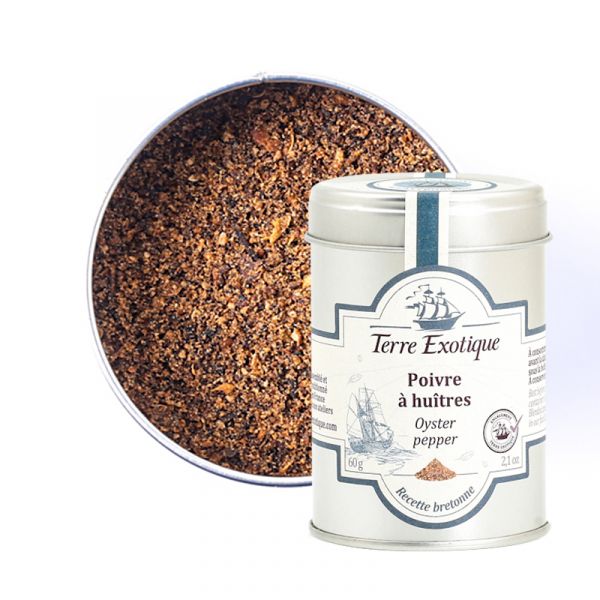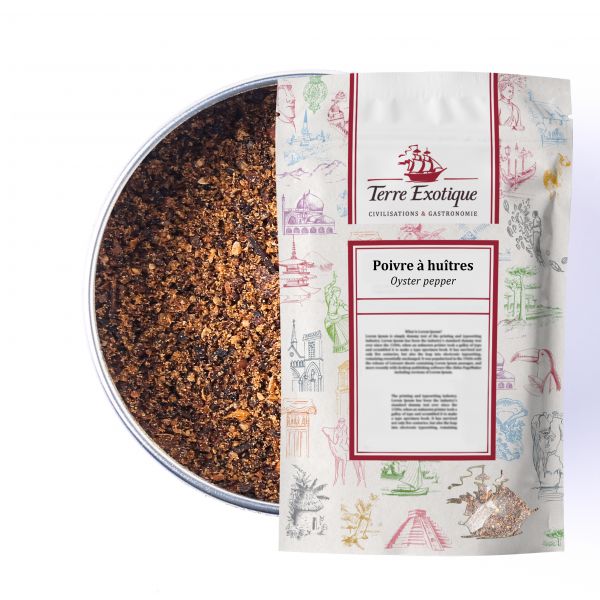







How to Enjoy Your Oysters? That's the Question!
Ideal with meats, surprising on a fruit salad, sublime on a goat cheese toast, and obviously perfect on oysters!If you decide to eat them raw:
You should know that serving oysters on ice is not the right method. Indeed, they could be too cold and the flavors more bland. You could also have difficulty digesting them. To develop the flavors of oysters, serve them on seaweed or coarse salt.
For seasoning oysters, there are several possibilities. You can season your oysters with fresh lemon juice, a mixture of shallots and red wine vinegar, but why not enjoy your oysters with pepper? Choose oyster pepper that will enhance the much-appreciated iodine taste, thanks to its 6 crushed peppers.
If you prefer to eat them cooked:
Eating oysters hot is a good alternative for those who are not fans of oysters or who have never eaten them. Grilled on the barbecue or baked in the oven, you can pair your oysters with garlic butter, curry cream, or cider sauce.
- Oysters gratin with white wine: discover the Terre Exotique recipe here
Recipe Idea: Oyster Plate with Pepper
For a dozen oysters, plan on 1 tablespoon of oyster pepper. Start by preparing your oysters: open them, put a pinch of oyster pepper on each one, serve, and enjoy immediately!
Intense Notes to Reveal all the Iodine Aromas
Both honeyed and fruity thanks to the cubeb pepper, lemony and fresh thanks to the Timur berry, enveloped by delicate aromas of sweet spices and fruits that perfectly complement your oysters or seafood.
6 Crushed Peppers to Reveal Iodine Flavors
A blend that pairs perfectly with iodine made up of Voatsiperifery black pepper, cubeb pepper, Penja white pepper, Timur berry, Jamaican pepper.Voatsiperifery black pepper originates from Madagascar; its name comes from "voa" meaning fruit and "tsiperifery" which is the name of the plant in Malagasy. Voatsiperifery grows wild in the tropical forest of southeastern Madagascar. This "wild pepper" only fruits on young shoots.
Cubeb pepper originates from Southwest India, Sumatra, Java, and Borneo. It is a small pepper grain with a stalk harvested in Indonesia. Cubeb pepper is obtained from berries, harvested before maturity, dried, and ground.
Penja white pepper is the fruit of a giant vine: Piper nigrum. It grows on a tree with rough and cracked bark that facilitates its ascent, often up to four meters high. Its pollination is done by rain, frequent in the Moungo region. The volcanic, rich, and fertile lands of Cameroon give Penja pepper an exceptional aroma and concentration of essential oils.
Originating from Nepal, Timur berry is harvested from small trees endemic to the Zanthoxylum armatum species of the Rutaceae family. It grows wild in the Mahabharat range between the Terai and the Pahar, at an altitude of over 2000 meters.
Jamaican pepper is a dried fruit. It produces a tree named Pimenta dioica that can reach up to 30 meters in height. Originally from Jamaica, Mexico, and the islands of Cuba and Haiti, Jamaican pepper is becoming increasingly popular in Brazil and Guatemala..
Where Does Oyster Pepper Come From?
The Story of a High-Aroma Blend
At the end of the 18th century, eating live oysters was fashionable. In the book, La Cuisine Bourgeoise dating from 1774, it is written that they "are usually eaten raw with pepper." The desire of Terre Exotique was therefore to create a blend that could reveal all the flavors of the oyster and the iodine; this is where oyster pepper was born, a blend rich in aromas that leaves all its room for iodine once in the mouth.Oyster pepper is available in the custom-made pepper box dedicated to peppers from around the world
| Allergen | Absence |
|---|---|
| Native country | FRANCE |
| Ingredients | voatsiperifery pepper, black pepper, white pepper, cubebe pepper, |
| timur berry, allspice. | |
| Nutritional Info | / |
| TRACES EVENTUELLES D'ALLERGÈNES | céleri, sésame, moutarde, fruits à coques. |
 Français
Français 



